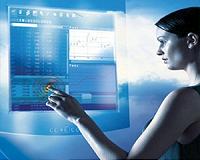 |
Durham NC (SPX) Jul 23, 2010 As physician-guided robots routinely operate on patients at most major hospitals, the next generation robot could eliminate a surprising element from that scenario - the doctor. Feasibility studies conducted by Duke University bioengineers have demonstrated that a robot - without any human assistance - can locate a man-made, or phantom, lesion in simulated human organs, guide a device to the lesion and take multiple samples during a single session. The researchers believe that as the technology is further developed, autonomous robots could some day perform many more simple surgical tasks. "Earlier this year we demonstrated that a robot directed by artificial intelligence can on its own locate simulated calcifications and cysts in simulated breast tissue with high repeatability and accuracy," said Kaicheng Liang, a former student in the laboratory of Stephen Smith, director of the Duke University Ultrasound Transducer Group at the Pratt School of Engineering and senior member of the research team. "Now we have shown that the robot can sample up to eight different spots in simulated human prostate tissue." The results of the Duke research appear in the current issue of the journal Ultrasonic Imaging. An earlier study reported in the January issue of the journal Ultrasound in Medicine and Biology described the Duke team's results on simulated breast tissue. In both experiments, whole turkey breasts were used. Raw turkey breasts are commonly used in medical research because the tissue closely resembles that of humans in texture and density, and appear similar when scanned by ultrasound. The Duke team combined a "souped-up" version of an existing robot arm with an ultrasound system of its own design. The ultrasound serves as the robot's "eyes" by collecting data from its scan and locating its target. The robot is "controlled" not by a physician, but by an artificial intelligence program that takes the real-time 3-D information, processes it and gives the robot specific commands to perform. The robot arm has a mechanical "hand" that can manipulate the same biopsy plunger device that physicians use to reach a lesion and take samples. In the latest series of experiments, the robot guided the plunger to eight different locations on the simulated prostate tissue in 93 percent of its attempts. This is important because multiple samples can also determine the extent of any lesion, Smith said. Smith believes that routine medical procedures, such as biopsies in other tissues in the body, will be performed in the future with minimal human guidance, and at greater convenience and less cost to patients. An important challenge to be overcome is the speed of data acquisition and processing, though the researchers are confident that faster processors and better algorithms will address that issue. To be clinically useful, all of the robot's actions would need to be in real time, the researchers said. "One of the beauties of this system is that all of the hardware components are already on the market," Smith said. "We believe that this is the first step in showing that with some modifications, systems like this can be built without having to develop a new technology from scratch." Advances in ultrasound technology have made these latest experiments possible, the researchers said, by generating detailed, 3-D, moving images in real-time. The Duke team has a long track record of modifying traditional 2-D ultrasound - like that used to image babies in utero - into the more advanced 3-D scans. The Duke lab invented the technique in 1991. "We're now testing the robot on a human mannequin seated at the examining table whose breast is constrained in a stiff bra cup," Smith said. "The breast is composed of turkey breast tissue with an embedded grape to simulate a lesion. Our next step is to move to an excised human breast."
Share This Article With Planet Earth
Related Links Duke University Hospital and Medical News at InternDaily.com
 Talking Touchscreens And Patients
Talking Touchscreens And PatientsChicago IL (SPX) Jul 14, 2010 Multimedia talking touchscreens, housed in computer kiosks at clinics and hospitals, are helping researchers at Northwestern University Feinberg School of Medicine and clinicians at local health care centers enhance patient-centered care for patients with diverse language, literacy and computer skills. The easy-to-use touchscreens read questionnaires, provide patient education material and ... read more |
|
| The content herein, unless otherwise known to be public domain, are Copyright 1995-2010 - SpaceDaily. AFP and UPI Wire Stories are copyright Agence France-Presse and United Press International. ESA Portal Reports are copyright European Space Agency. All NASA sourced material is public domain. Additional copyrights may apply in whole or part to other bona fide parties. Advertising does not imply endorsement,agreement or approval of any opinions, statements or information provided by SpaceDaily on any Web page published or hosted by SpaceDaily. Privacy Statement |